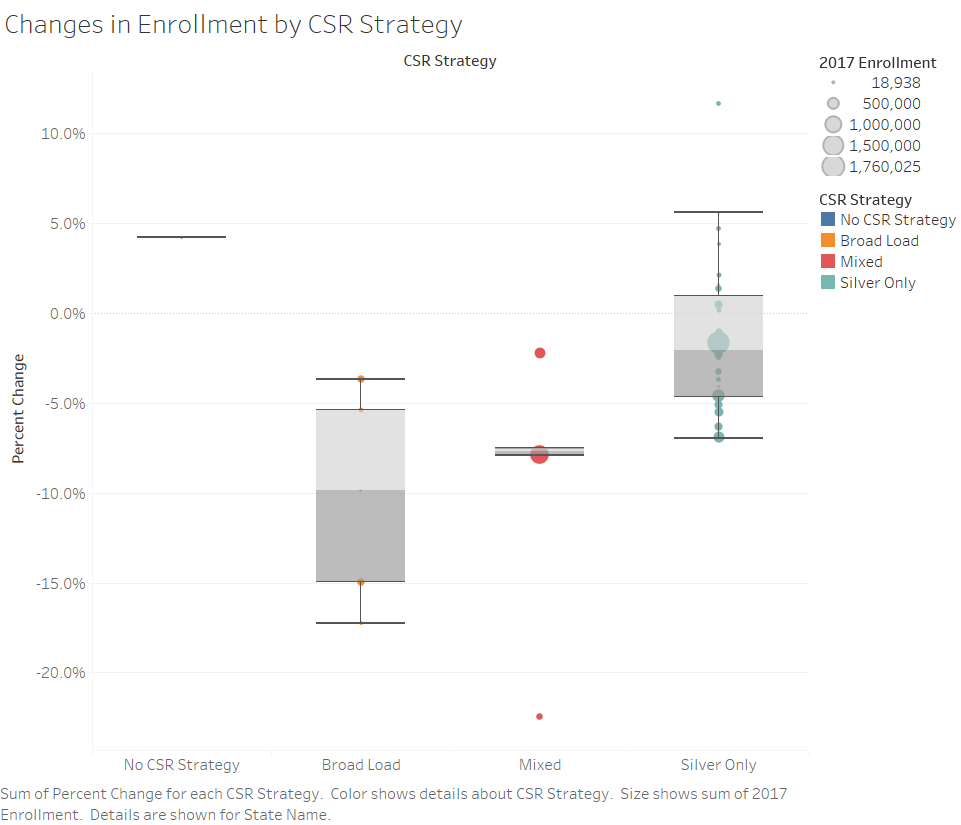We looked at a quick and dirty change in enrollment on Healthcare.gov yesterday. Overall enrollment on Healthcare.gov was down by about 4%.There was wide variance with Kentucky gaining more than 10% of its 2017 enrollment and Louisiana dropping over 20% of its enrollment. The ACA faced several massive shocks this year. The termination of Cost Sharing Reduction (CSR) was one of them. Most states had a plan to cope with CSR but that plan varied.
Below is a very quick state level chart of how the four different strategies played out. Silver Load meant that a state had every insurer put all of the CSR costs only onto the Silver plans. Broad Load had a state put the cost of CSR into all plans. No CSR Strategy was the North Dakota response of nothing while Mixed responses had insurers in a given state do many different things.
I am not controlling for anything. I think that there is a strong case to control for price spreads, network quality, insurer longevity and probably political orientation. An analysis that goes into a peer reviewed journal probably needs to be focused at the county level with a boat load of controls. I would be fascinated to see what has happened in the Mixed Strategy states as there are a couple of different flavors of mixed strategies.
This primarily is for my intuition. And it looks like nothing is obviously statistically significant. The outliers that I am very curious about are Louisiana and Arizona on the downside while Georgia and Kentucky seem to be upside surprises. I think there is preliminary evidence that Silver Loading helped enrollment compared to either Broad Loading or mixed responses but this will be dependent on better data and better methods than I have.


WereBear
A great topic is how insurance machinations affect the health providers, too.
Overhead to thread the maze of different insurance companies is considerable. Doctors wind up figuring out how the patient will pay for what they suggest as much as they figure out the best thing to suggest.
Yutsano
I wonder how much of this is due to the recent expansion of Medicaid in both Louisiana and Arizona,
Yarrow
@WereBear: I commented about my situation in David’s other thread below, but this is a good observation. I’m going to be working with a couple of my doctors to figure out how to get lab work paid for next year. It’s going to be a real pain. How that happens will in turn affect my ability to keep seeing those doctors, so maybe they’ll have an incentive to keep a customer.
Doctors can also suggest patients do X, but if the patient’s insurance company doesn’t cover it, many patients can’t afford it out of pocket. So doctors may modify what they suggest patients do based on what insurance will cover.
David Anderson
@Yutsano: Louisiana has a plausible Medicaid story. I don’t think it is a strong story, but it is a plausible story.
Arizona expanded Medicaid effective 1/1/14 so there is no plausible Medicaid story. There probably is a pricing story but I need time to look into that.
Dave
Charles Gaba
Important to note that this only includes the 39 states on HC.gov; the 12 SBMs are missing, 9 of which went Silver Load. CO went Broad Load. DC & VT went “no load” but DC has virtually zero CSR enrollees anyway. Still not sure what arrangement was come to in VT.
Raoul
OT but curious if you have any thoughts on this, David? What are the longer term implications of US for-profit insurers (that appear to be throwing off plenty of free cash, btw), buying up big $$ foreign transactions?
Thanks